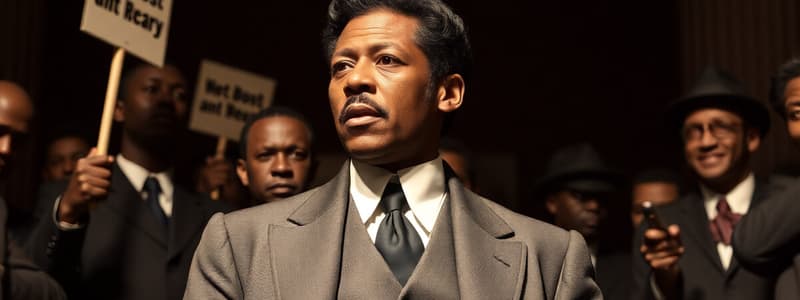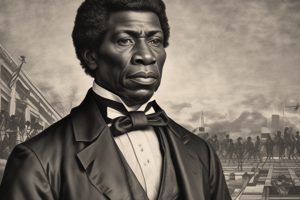Podcast
Questions and Answers
Explain how the Dred Scott decision contributed to the start of the Civil War.
Explain how the Dred Scott decision contributed to the start of the Civil War.
The Dred Scott decision denied citizenship to enslaved people, intensifying the conflict between pro-slavery and anti-slavery factions and pushing the nation closer to war.
How did the 14th Amendment effectively overturn the Dred Scott Supreme Court decision?
How did the 14th Amendment effectively overturn the Dred Scott Supreme Court decision?
The 14th Amendment declared that all persons born or naturalized in the United States are citizens, nullifying the Dred Scott decision that denied citizenship to those of African descent.
Describe how Black Codes undermined the protections granted by the 13th, 14th, and 15th Amendments.
Describe how Black Codes undermined the protections granted by the 13th, 14th, and 15th Amendments.
Black Codes restricted the rights and freedoms of newly freed slaves through vagrancy laws, restrictions on property ownership, and prohibitions on carrying firearms, thus limiting the impact of the amendments.
What was the “separate but equal” doctrine established in Plessy v. Ferguson, and what effect did it have on American society?
What was the “separate but equal” doctrine established in Plessy v. Ferguson, and what effect did it have on American society?
Explain how literacy tests and poll taxes were used to disenfranchise African American voters during the Jim Crow era.
Explain how literacy tests and poll taxes were used to disenfranchise African American voters during the Jim Crow era.
How did the Grandfather Clause perpetuate racial inequality in voting rights?
How did the Grandfather Clause perpetuate racial inequality in voting rights?
What were the main goals of the National American Women’s Suffrage Association (NAWSA)?
What were the main goals of the National American Women’s Suffrage Association (NAWSA)?
In what way did the Brown v. Board of Education case challenge the precedent set by Plessy v. Ferguson?
In what way did the Brown v. Board of Education case challenge the precedent set by Plessy v. Ferguson?
Describe the key arguments and outcome of the Mendez v. Westminster case regarding the segregation of Mexican-American students.
Describe the key arguments and outcome of the Mendez v. Westminster case regarding the segregation of Mexican-American students.
Explain the significance of the Loving v. Virginia Supreme Court case in the context of civil rights.
Explain the significance of the Loving v. Virginia Supreme Court case in the context of civil rights.
How did the vagrancy laws in the Black Codes criminalize and exploit newly freed slaves?
How did the vagrancy laws in the Black Codes criminalize and exploit newly freed slaves?
What was the impact of literacy tests on African American voter registration during the Jim Crow era?
What was the impact of literacy tests on African American voter registration during the Jim Crow era?
Discuss the role of the 19th Amendment in expanding civil rights in the United States.
Discuss the role of the 19th Amendment in expanding civil rights in the United States.
Explain how the civil rights movement influenced the government to enforce civil rights laws and constitutional amendments.
Explain how the civil rights movement influenced the government to enforce civil rights laws and constitutional amendments.
How did the Supreme Court’s decision in Plessy v. Ferguson affect the access of African Americans to public facilities?
How did the Supreme Court’s decision in Plessy v. Ferguson affect the access of African Americans to public facilities?
What specific right did the 15th Amendment grant to African American men, and why was it significant?
What specific right did the 15th Amendment grant to African American men, and why was it significant?
Compare and contrast the impact of the 14th and 15th Amendments on civil rights.
Compare and contrast the impact of the 14th and 15th Amendments on civil rights.
In what ways did the Black Codes limit the economic opportunities of freedmen in the South?
In what ways did the Black Codes limit the economic opportunities of freedmen in the South?
How did the Supreme Court's ruling in Brown v. Board of Education lead to social change beyond just desegregating schools?
How did the Supreme Court's ruling in Brown v. Board of Education lead to social change beyond just desegregating schools?
Explain how the Loving v. Virginia case addressed the issue of discrimination based on both race and personal freedom.
Explain how the Loving v. Virginia case addressed the issue of discrimination based on both race and personal freedom.
How did the grandfather clause circumvent the intentions of the 15th Amendment?
How did the grandfather clause circumvent the intentions of the 15th Amendment?
Why was the Mendez v. Westminster case a significant precursor to Brown v. Board of Education?
Why was the Mendez v. Westminster case a significant precursor to Brown v. Board of Education?
In what ways did the Black Codes aim to restore elements of the pre-Civil War social hierarchy in the South?
In what ways did the Black Codes aim to restore elements of the pre-Civil War social hierarchy in the South?
How did the poll tax act as a barrier to voting rights for both African Americans and poor white citizens?
How did the poll tax act as a barrier to voting rights for both African Americans and poor white citizens?
How did the 19th Amendment alter the composition of the American electorate and its potential impact on public policy?
How did the 19th Amendment alter the composition of the American electorate and its potential impact on public policy?
How did the enforcement of the Fourteenth Amendment challenge the concept of state sovereignty in matters of civil rights?
How did the enforcement of the Fourteenth Amendment challenge the concept of state sovereignty in matters of civil rights?
How did the abolition of slavery through the 13th Amendment lay the groundwork for subsequent civil rights advancements?
How did the abolition of slavery through the 13th Amendment lay the groundwork for subsequent civil rights advancements?
How do civil rights issues continue to stimulate protest, specifically when previous gains appear to be threatened?
How do civil rights issues continue to stimulate protest, specifically when previous gains appear to be threatened?
What was one of Chief Justice Roger's arguments when he ruled against Dred Scott?
What was one of Chief Justice Roger's arguments when he ruled against Dred Scott?
How did black codes lead to a separation doctrine?
How did black codes lead to a separation doctrine?
Flashcards
Civil Rights
Civil Rights
Rights of individuals to receive equal treatment and freedom from unfair discrimination.
Dred Scott v. Sandford
Dred Scott v. Sandford
Supreme Court case where a slave sued for his freedom based on living in a free territory; the Court denied his rights deeming he was not a citizen.
13th Amendment
13th Amendment
Abolished slavery and involuntary servitude in the United States.
14th Amendment
14th Amendment
Signup and view all the flashcards
15th Amendment
15th Amendment
Signup and view all the flashcards
Black Codes (Historical)
Black Codes (Historical)
Signup and view all the flashcards
Vagrancy laws
Vagrancy laws
Signup and view all the flashcards
Plessy v. Ferguson
Plessy v. Ferguson
Signup and view all the flashcards
Jim Crow Laws
Jim Crow Laws
Signup and view all the flashcards
Literacy Tests
Literacy Tests
Signup and view all the flashcards
Grandfather Clause
Grandfather Clause
Signup and view all the flashcards
Poll Tax
Poll Tax
Signup and view all the flashcards
19th Amendment
19th Amendment
Signup and view all the flashcards
Brown v. Board of Education
Brown v. Board of Education
Signup and view all the flashcards
Mendez v. Westminster 1946
Mendez v. Westminster 1946
Signup and view all the flashcards
Loving v. Virginia 1967
Loving v. Virginia 1967
Signup and view all the flashcards
Study Notes
- Civil rights are fundamental rights that ensure equal treatment and protection under the law for all citizens, preventing discrimination based on race, religion, gender, etc. and guaranteeing equal access to opportunities and resources.
- Civil Rights Movements fought for the rights of minorities who experienced discrimination.
Dred Scott v. Sandford
- Dred Scott, a slave, sued for his freedom in 1857 after living in a free territory.
- The Supreme Court ruled against Scott, stating that as a slave, he was not a citizen and had no right to sue.
- Chief Justice Roger declared individuals of African ancestry were not intended to be included as citizens in the Constitution.
- The Dred Scott decision pushed the nation closer to the Civil War by solidifying the pro-slavery stance of the South.
Amendments After the Civil War
- Amendments were created after the Civil War to protect newly freed slaves.
- The 13th Amendment abolished slavery in the entire United States and granted Congress the power to enforce this.
- The Emancipation Proclamation only ended slavery in the Confederacy.
- The 14th Amendment ensured the Bill of Rights applied to all U.S. citizens, regardless of race and allowed the federal government to challenge states violating citizens' rights based on race.
- The 14th Amendment overturned the Dred Scott decision by declaring everyone born in the U.S. (including Black men and former slaves) citizens.
- The 15th Amendment secured voting rights for Black men, making it illegal to deny them the right to vote based on race or previous servitude.
Black/Slave Codes
- Southern state legislatures created Black/slave codes to suppress the newly freed slave population.
- These codes promoted the separation of “white Americans” and freed “black” Americans (Freedmen).
- Vagrancy laws made it illegal for Black people to be unemployed or without a fixed residence.
- Freedmen were prohibited from carrying firearms.
- Interracial marriage was prohibited.
- Restrictions were placed on property and business ownership for African Americans.
Plessy v. Ferguson
- In 1896, the Supreme Court upheld racial segregation under the "separate but equal" doctrine.
- Homer Plessy was arrested for refusing to leave a whites-only railroad car in Louisiana.
- The Supreme Court ruled that segregation was constitutional if facilities were equal.
- Plessy v. Ferguson established the legal precedent for segregation for over half a century.
Jim Crow Laws
- Jim Crow laws enforced racial segregation and discrimination against African Americans, mainly in the South.
- These laws segregated public facilities like schools, parks, transportation, and restaurants.
- African Americans were often forced to use separate, inferior facilities.
- Literacy tests were used to prevent African Americans from voting by administering difficult tests.
- Grandfather clauses allowed individuals to vote if their grandfathers were eligible before the Civil War, exempting white voters from new requirements.
- Poll taxes were fees required to vote, preventing many African Americans and poor white voters from exercising their right to vote.
19th Amendment
- The 19th Amendment was ratified on August 26, 1920, granting women the right to vote.
- Women formed the National American Women’s Suffrage Association (NAWSA) to advocate for voting rights.
- Wyoming had granted women the right to vote in 1869, and by 1912, at least half of the states allowed women to vote.
Brown v. Board of Education
- In 1954, the Supreme Court ruled that segregation in education was unequal and illegal.
- Linda Brown had to travel a mile to a black school despite living one block from a white school.
- Brown v. Board of Education overturned the Plessy v. Ferguson ruling, making segregation in schools illegal.
More Supreme Court Cases
- In 1946, Mendez v. Westminster, a federal court ruled that segregation of Mexican-American students in California's public schools was unconstitutional.
- In Loving v. Virginia (1967), the Supreme Court struck down state laws banning interracial marriage, ruling them a violation of the Fourteenth Amendment.
- Loving v. Virginia involved Mildred and Richard Loving, who were sentenced for marrying in Washington D.C. and returning to Virginia, which had anti-miscegenation laws.
Studying That Suits You
Use AI to generate personalized quizzes and flashcards to suit your learning preferences.




